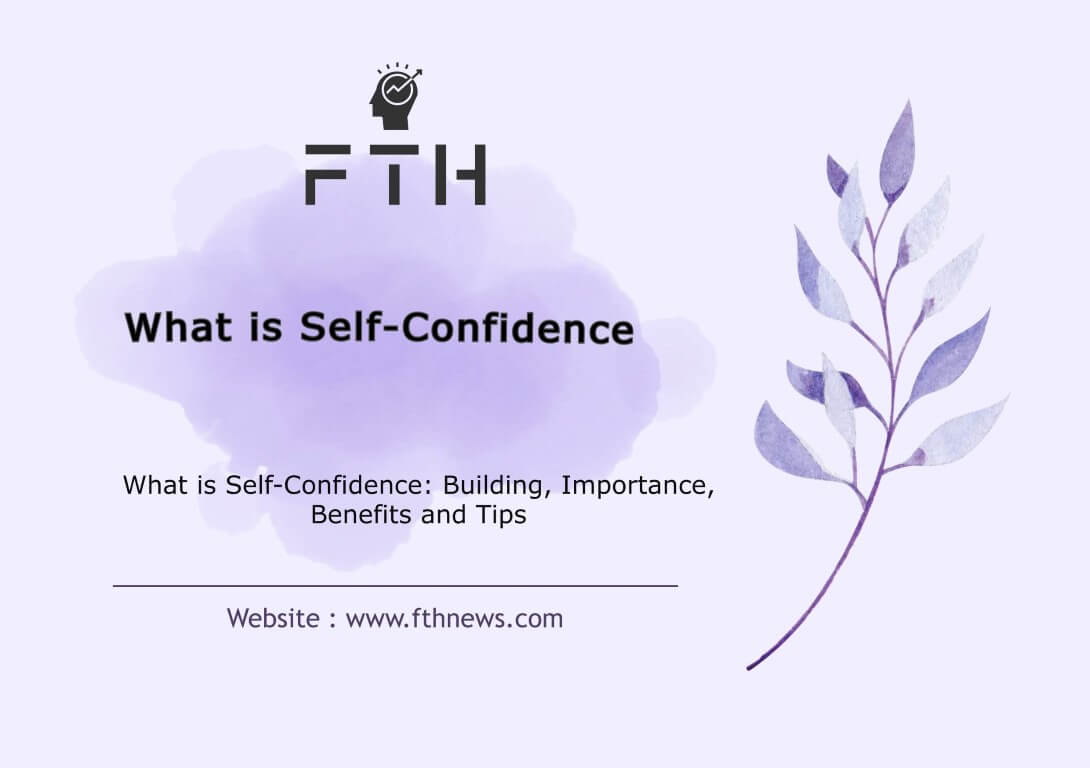
What is Self-Confidence: Building, Importance, Benefits and Tips
Do you ever find yourself feeling weak or defenseless in certain situations? The key to overcoming such challenges lies in understanding and developing self-confidence. In this blog post, we will explore what self-confidence is, how to gain it, and provide effective solutions for overcoming its lack. Life coach and bestselling author Barrie Davenport once said, “Low self-esteem is a prison, but not forever. Trust, like all skills, is learnable and can be applied for self-improvement.” Let’s delve into the journey of discovering and enhancing self-confidence.
Definition of Self-Confidence:
According to Webster’s dictionary, self-confidence is the belief in one’s own abilities. It is influenced by various factors, including genetics, childhood experiences, societal attitudes, work and relationships, physical health, media influence, and individual skills.
Remember, self-confidence is not an innate trait; it can be developed and strengthened over time with commitment and effort.
In conclusion, the journey to self-confidence is unique for each individual. By understanding its definition, recognizing influencing factors, and implementing practical solutions, you can embark on a transformative path towards a more confident and fulfilling life.
What is Self Confidence ?
Before we embark on the journey to boost your self-confidence, let’s take a closer look at what self-confidence truly means. It goes beyond mere bravado or surface-level assurance; it’s a profound understanding of oneself, a harmonious acceptance of one’s identity, and an unwavering belief in personal abilities.
Self-confidence isn’t a one-size-fits-all concept; it’s a dynamic trait that adapts to various situations. At its core, it’s about knowing who you are, finding solace in your uniqueness, and trusting in your capabilities. However, the degree of self-confidence can fluctuate depending on the circumstances you find yourself in.
At the heart of self-confidence lies a strong foundation of healthy self-esteem. This involves cultivating positive feelings about the disparity between your current self and the aspirational self you strive to become. Picture it as the fertile soil in which the seeds of self-confidence can take root and flourish.
Positive thinking acts as the catalyst for self-confidence. It’s not just about seeing the glass half full; it’s about fostering a mindset that actively contributes to your happiness and success. This optimistic outlook becomes your steadfast companion, offering support even when faced with the most challenging situations.
True self-confidence is resilient—it endures through adversity. When the storms of life arrive, and challenges seem insurmountable, it’s your self-confidence that stands firm. It’s this unwavering belief in yourself that propels you forward, helping you navigate difficulties with grace and determination.
In essence, self-confidence is a dynamic force that evolves from within, rooted in positive self-perception and resilience. It’s not a fleeting emotion but a steadfast companion on your journey to personal and professional success. Now, armed with a clearer understanding of self-confidence, let’s delve into practical strategies to nurture and enhance this vital trait.
Where Does Self-Confidence Come From?
Unveiling the Roots of Self-Confidence: The Three Pillars
Now that we’ve explored what self-confidence entails, let’s uncover its origins—three essential abilities that serve as the pillars supporting this empowering trait.
1. Positive Thinking: The Cornerstone
At the heart of self-confidence lies the cornerstone of positive thinking. It involves not just acknowledging your capabilities but wholeheartedly believing in them. When you cultivate a mindset that champions your strengths and embraces challenges as opportunities for growth, you lay the groundwork for a robust self-confidence.
Positive thinking isn’t about unrealistic optimism; it’s a pragmatic approach to viewing your abilities and potential. It’s recognizing that setbacks are part of the journey and that each stumble is a stepping stone towards improvement. By anchoring your self-perception in positivity, you fortify the foundation upon which self-confidence flourishes.
2. Confidence in Positivity: A Shield Against Doubt
Maintaining a positive outlook amid external doubts is the second crucial pillar. It’s not uncommon for others’ skepticism or criticism to cast shadows on your self-assurance. However, true self-confidence stands tall even in the face of doubt, unwavering in its commitment to a positive narrative.
Confidence in positivity acts as a shield, deflecting external negativity and reinforcing your internal belief system. This resilience allows you to navigate external pressures without compromising the core of your self-confidence. It’s about recognizing your worth despite external opinions and trusting in the journey you’ve chosen for yourself.
3. Consistent Positive Thinking: The Art of Perseverance
The third pillar, consistent positive thinking, is the art of perseverance in positive self-reflection. Building and maintaining self-confidence is not a one-time effort but a continuous journey. It requires the discipline to persistently reflect on your positive attributes, achievements, and growth, even when faced with challenges.
Consistent positive thinking involves celebrating small victories, acknowledging progress, and learning from setbacks. It’s the ongoing conversation you have with yourself, reinforcing the belief that you possess the resilience and capability to overcome any obstacles. This sustained positive dialogue becomes the driving force behind enduring self-confidence.
Nurturing the Pillars for Lasting Self-Confidence
Developing and utilizing these three fundamental skills—positive thinking, confidence in positivity, and consistent positive thinking—is instrumental in building and maintaining self-confidence. They collectively create a robust support system that empowers you to face challenges, embrace growth, and stay resilient in the pursuit of your goals.
As we move forward on this journey to enhance your self-confidence, keep these pillars in mind. They will serve as your guiding principles, empowering you to unlock your true potential and cultivate a self-confidence that stands the test of time.
How to Gain Self-Confidence:
Embarking on the Path to Confidence: Practical Strategies for Self-Discovery
Now that we understand the essence of self-confidence and its roots, let’s delve into actionable strategies to cultivate and enhance this empowering trait. If you’re resolute about boosting your self-confidence, consider integrating the following practices into your daily routine:
1. Surround Yourself with Positivity: Cultivating a Supportive Environment
Your surroundings play a pivotal role in shaping your mindset. Evaluate your environment, including friends, family, and colleagues. Surround yourself with individuals who uplift, inspire, and encourage your personal and professional growth. Distance yourself from those who bring negativity or doubt into your life.
Positivity is contagious, and being amidst uplifting energy can significantly impact your self-confidence. Engage in conversations that nurture your spirit and contribute positively to your well-being. A positive support system acts as a bedrock for building and sustaining self-confidence.
2. Adjust Body Language and Image: Non-Verbal Confidence
Body language is a powerful communicator of confidence. Projecting confidence through your posture, gestures, and overall demeanor can influence both your perception of yourself and how others perceive you. Stand tall, maintain eye contact, and exude enthusiasm in your interactions.
Moreover, pay attention to your personal image. Dress in a way that aligns with your self-perception and the confidence you wish to convey. When you align your external presentation with your internal sense of confidence, it creates a harmonious image that reinforces your belief in yourself.
3. Embrace Failure Positively: A Stepping Stone to Growth
Failure is not a roadblock but a stepping stone on the path to growth and self-discovery. Refuse to accept failure as a verdict on your abilities. Instead, view it as an opportunity to learn, adapt, and refine your approach. Every setback is a lesson that contributes to your personal and professional development.
Silence the negative inner voices that may arise in the face of failure. Replace self-criticism with self-compassion, acknowledging that setbacks are part of the journey toward success. By embracing failure positively, you not only build resilience but also fortify the foundation of your self-confidence.
4. Be Prepared: Knowledge as a Confidence Booster
Confidence thrives on competence. Acquire knowledge and skills related to your field of interest. Preparation is a powerful confidence booster, allowing you to approach challenges with a sense of readiness and assurance. Whether it’s a presentation, a project, or a personal goal, thorough preparation instills confidence in your abilities.
Continuously seek opportunities to expand your knowledge and refine your skills. The more equipped you are, the more confident you’ll feel in tackling various situations. Confidence born from preparation is not just about knowing; it’s about trusting that you have the tools to excel.
5. Endure Hard Times: Building Resilience
Life is replete with challenges, and enduring hard times is an inevitable part of the human experience. Recognize these challenges as opportunities for growth. During moments of difficulty, create lists of your accomplishments and things you are grateful for. Revisit these lists during challenging times to draw inspiration and remind yourself of your capabilities.
Enduring hard times builds resilience—a key attribute of self-confidence. It reinforces the idea that you can navigate adversity and emerge stronger on the other side. The ability to find strength and gratitude in challenging moments enhances your overall confidence in your capacity to overcome obstacles.
As you integrate these practices into your daily routine, remember that building self-confidence is a continuous journey. Each step forward contributes to your personal growth and the cultivation of lasting self-assurance. Stay committed to the process, and you’ll find yourself on a transformative path toward a more confident and empowered version of yourself.
Solutions for Lack of Self-Confidence
Recognizing and addressing the characteristics of low self-confidence is a pivotal step in the journey toward personal growth and empowerment. Let’s delve into effective solutions for cultivating a resilient and positive self-confidence:
1. Stop Self-Deprecation: Embrace the Power of Self-Love
Self-deprecation is the silent underminer of self-confidence. To break free from this destructive cycle, embrace the power of self-love. Challenge negative thoughts and replace self-criticism with self-compassion. Understand that everyone makes mistakes, and these moments are opportunities for learning and growth.
Affirmations can be powerful tools in reshaping your self-perception. Start your day with positive affirmations that reinforce your strengths and capabilities. Over time, these affirmations can become ingrained in your mindset, fostering a more positive and confident self-image.
2. Pamper Yourself: A Holistic Approach to Confidence
Self-confidence is not solely about mental resilience; it encompasses your entire being. Paying attention to your appearance, posture, and overall well-being contributes to a holistic sense of confidence. When you feel good physically, it positively impacts your mental and emotional state.
Invest time in self-care activities that bring you joy and relaxation. Whether it’s indulging in a hobby, practicing mindfulness, or taking care of your physical health, these actions collectively contribute to a more confident and balanced version of yourself.
3. Strengthen Persuasion Skills: Confidence in Communication
Effective communication is a cornerstone of self-confidence. Strengthen your persuasion skills by developing the ability to express thoughts confidently and assertively. Practice articulating your ideas with clarity and conviction, both verbally and in writing.
Engage in activities that enhance your communication skills, such as public speaking, writing, or participating in group discussions. The more comfortable and skilled you become in expressing yourself, the more confident you’ll feel in various social and professional interactions.
4. Set Achievable Goals: Building Confidence Gradually
Avoid overwhelming situations that trigger low self-confidence by setting achievable goals. Be prepared and approach challenges with a step-by-step mindset. Break down larger tasks into smaller, manageable steps, allowing for a sense of accomplishment at each stage.
Setting realistic goals provides a roadmap for success and builds confidence gradually. Celebrate every achievement, no matter how small, and use each success as a stepping stone toward larger aspirations. This incremental approach reinforces your belief in your ability to overcome challenges.
5. Express Gratitude: Focusing on Strengths and Achievements
Compile lists of your strengths, achievements, and things to be proud of. Expressing gratitude for your positive attributes shifts the focus from perceived shortcomings to the wealth of qualities that make you unique and capable.
Regularly revisit these lists, especially during moments of self-doubt. Reflecting on your strengths and past achievements serves as a powerful reminder of your capabilities. This practice not only boosts self-confidence but also fosters a mindset of gratitude and positivity.
6. Continuous Improvement: Embracing a Growth Mindset
Acknowledge your strengths, reward your efforts, and celebrate progress. Instead of dwelling on failure, view setbacks as opportunities for learning and improvement. Embrace a growth mindset that sees challenges as stepping stones to greater success.
Cultivate a commitment to continuous improvement. Seek out learning opportunities, both personally and professionally. Engage in activities that challenge you and push you outside your comfort zone. The more you embrace a mindset of growth, the more resilient and self-assured you become.
By implementing these solutions, you embark on a transformative journey toward overcoming low self-confidence. Remember, building self-confidence is an ongoing process, and each positive change contributes to the development of a more empowered and confident version of yourself.
The Importance of Self-Confidence:
In the intricate dance of life, self-confidence emerges as the orchestrator of effective actions and the antidote to stagnation. Let’s delve into the profound importance of self-confidence, unraveling its role in propelling individuals toward impactful and quality-driven endeavors.
1. Initiating Effective Actions: The Catalyst of Progress
At its core, self-confidence serves as the driving force behind taking initiative. When individuals possess confidence in their abilities, they are more likely to step forward and initiate actions. This proactive approach is instrumental in navigating the challenges of personal and professional spheres.
Consider a scenario where self-doubt lingers. Without self-confidence, the inertia of inaction may prevail, hindering progress and potential success. In contrast, a confident individual is empowered to initiate actions with conviction, setting the stage for growth, achievement, and fulfillment.
2. Executing Tasks with Quality: A Mark of Excellence
Self-confidence is not merely a catalyst for action; it is also the linchpin of executing tasks with excellence. When individuals believe in their abilities, they approach tasks with a sense of competence and assurance. This mindset significantly influences the quality of their work.
Confident individuals are more likely to tackle challenges head-on, leveraging their skills and knowledge to deliver exceptional results. The assurance in their capabilities fuels a commitment to excellence, creating a positive feedback loop where quality efforts reinforce and enhance self-confidence.
3. Establishing a Positive Feedback Loop: The Confidence Cycle
The relationship between self-confidence and actions creates a powerful feedback loop. Initiating actions with confidence leads to successful outcomes, reinforcing the belief in one’s abilities. This positive feedback loop becomes a self-perpetuating cycle, each success enhancing and solidifying self-confidence.
Conversely, when self-doubt prevails and actions are hindered, the absence of positive outcomes reinforces the cycle of insecurity. Understanding this dynamic underscores the critical role of self-confidence in breaking free from the shackles of self-doubt and creating a trajectory of continuous growth and success.
4. Breaking the Cycle of Self-Doubt: A Crucial Understanding
Recognizing the importance of self-confidence is paramount for breaking the cycle of self-doubt. It’s not merely a trait but a dynamic force that propels individuals beyond their comfort zones, fostering resilience in the face of challenges. Understanding its significance becomes a transformative step toward embracing a life characterized by initiative, excellence, and continuous advancement.
In essence, self-confidence is the key that unlocks the doors of potential, enabling individuals to navigate the complexities of life with purpose and assurance. As you grasp its importance, you equip yourself with a potent tool to counteract self-doubt and embark on a journey of self-discovery, growth, and meaningful achievement.
How to Strengthen Self-Confidence:
Strategies to Strengthen Self-Confidence
Building self-confidence is a dynamic process that requires introspection and intentional actions. Let’s explore practical strategies to fortify your confidence, considering the influential factors:
1. Identify Obstacles: Unmasking Barriers to Confidence
The first step to strengthening self-confidence is to identify and acknowledge the obstacles in your path. These obstacles may manifest as self-doubt, fear of failure, or external pressures. Recognizing these factors is crucial for developing targeted strategies to overcome them.
Reflect on situations where you feel a lack of confidence and examine the underlying challenges. Whether it’s negative self-talk, past experiences, or societal expectations, understanding these obstacles empowers you to navigate them effectively. This awareness lays the groundwork for building a more resilient and confident mindset.
2. Know Yourself: Embracing Self-Discovery
Self-confidence thrives on self-awareness. Take the time to understand your personality traits, strengths, and weaknesses. Conduct a thorough self-assessment, seeking insights into what makes you unique and valuable.
Identify your core values and beliefs, as they play a significant role in shaping your confidence. Embrace your strengths and acknowledge areas for growth without self-judgment. Knowing yourself intimately fosters a genuine and unwavering confidence grounded in authenticity.
3. Learn Practical Skills: Aligning Skills with Values
Acquiring practical skills aligned with your personal values is a potent way to boost self-confidence. Identify areas where you can enhance your capabilities and align them with your passions and values. This could involve professional skills, interpersonal communication, or personal hobbies.
Continuous learning not only enriches your skill set but also reinforces your belief in your ability to adapt and grow. Seek out opportunities for education and skill development that align with your interests. As you expand your knowledge and expertise, you build a reservoir of confidence that extends across various facets of your life.
4. Embrace Challenges: Stepping Outside the Comfort Zone
Challenges are not adversaries but allies in the journey to self-confidence. Embrace situations that push you outside your comfort zone, as these experiences foster growth and resilience. Tackling challenges head-on builds a track record of overcoming obstacles, contributing to a robust sense of self-assurance.
Start with small challenges and progressively take on more significant endeavors. Whether it’s initiating a difficult conversation, volunteering for a new project, or pursuing a passion project, each challenge becomes a stepping stone toward heightened confidence. Embracing challenges is a proactive way to demonstrate your capabilities to yourself and others.
5. Cultivate a Positive Mindset: Nurturing Optimism
A positive mindset is a cornerstone of self-confidence. Cultivate optimism by reframing negative thoughts and focusing on the potential for success. Practice gratitude for your achievements, no matter how small, and acknowledge your progress along the way.
Challenge self-limiting beliefs and replace them with affirmations that reinforce your confidence. Surround yourself with positivity, whether through supportive relationships, inspirational literature, or affirming visual cues. A positive mindset not only shapes your perception of yourself but also attracts opportunities for growth and success.
6. Seek Support and Feedback: Building a Support System
Don’t navigate the path to self-confidence alone. Seek support from mentors, friends, or colleagues who can provide constructive feedback and encouragement. Constructing a reliable support system creates a network of allies invested in your success.
Engage in open conversations about your goals and challenges, and welcome feedback as a valuable tool for improvement. Having a support system not only offers guidance but also reinforces your belief that you’re not alone on your journey. Shared experiences and insights from others can illuminate new perspectives and strategies for building lasting self-confidence.
By incorporating these strategies into your life, you embark on a transformative journey toward strengthening your self-confidence. Remember that building confidence is a gradual process, and each intentional step contributes to the development of a more empowered and self-assured version of yourself.
Interesting Research on Self-Confidence:
Unveiling the Science of Confidence: Intriguing Research Insights
Delving into the realm of scientific inquiry reveals captivating findings that shed light on the intricate relationship between actions, mindset, and self-confidence. Explore these thought-provoking research discoveries that provide valuable insights into bolstering self-assurance:
1. The Impact of Clothing on Confidence
In the world of psychology, the connection between clothing and confidence has been a subject of intriguing research. Professor Karen J. Pine’s exploration, detailed in her book “Mind What You Wear,” delves into the transformative effect of clothing choices on one’s self-perception.
Research participants were asked to wear superhero costumes like Superman, and the results were remarkable. Wearing such attire not only made individuals feel more confident but also instilled a sense of strength and superiority. This study underscores the psychological influence that clothing can have on shaping our self-confidence and overall mindset.
Consider the power of intentional wardrobe choices in boosting your confidence. Dressing in a way that aligns with your self-perception can be a simple yet impactful strategy to cultivate confidence in various aspects of your life.
2. Small Successes and Confidence: A Winning Formula
A fascinating aspect of building confidence lies in the correlation between small successes and overall self-assurance. Research conducted on American swimmers preparing for the Olympic Games revealed an intriguing approach. Swimmers were encouraged to set small, achievable goals before the competition, such as improving their weekly start or refining a specific exercise.
These small successes not only contributed to enhanced performance but also had a profound effect on confidence levels. By celebrating incremental victories, individuals gained a sense of competence and belief in their abilities, creating a positive feedback loop that bolstered overall confidence.
Consider applying this principle in your own life by setting achievable goals. Acknowledge and celebrate even the smallest victories along your journey, as they contribute significantly to building a foundation of self-assurance.
3. Exercise and its Positive Influence
The relationship between physical activity and mental well-being has long been established, and research underscores the positive impact of exercise on self-confidence. Engaging in regular physical activity triggers the release of endorphins, the body’s natural mood enhancers.
Studies have shown that exercise not only improves overall mental health but also contributes to a more positive self-image. The endorphins released during physical activity interact with the brain’s receptors, fostering feelings of well-being and contentment. Incorporating exercise into your routine can be a potent strategy for enhancing both physical and mental confidence.
Whether it’s a brisk walk, a workout routine, or a fitness class, find an activity that brings you joy and contributes to your overall well-being. The positive effects on your mindset and self-confidence may pleasantly surprise you.
4. Meditation: A Pathway to Inner Confidence
The practice of meditation has gained recognition for its numerous benefits, including its positive impact on self-confidence. Studies conducted in 2008 explored the effects of meditation on the mind, revealing a reduction in negative emotions and an increase in mental strength.
Meditation exercises not only lower blood pressure but also improve overall mental agility. By cultivating mindfulness and fostering a sense of inner calm, meditation becomes a valuable tool for reducing self-doubt and enhancing self-confidence.
Consider incorporating meditation into your routine, even if it’s just a few minutes each day. The benefits extend beyond a tranquil mind, contributing to a more profound sense of self-assurance and resilience in the face of challenges.
These research findings provide a glimpse into the multifaceted nature of self-confidence and the diverse avenues through which it can be cultivated. Experiment with incorporating these insights into your life, and observe the transformative impact they may have on your journey to heightened self-assurance.
Self-Esteem vs. Self-Confidence: Understanding with Examples
While often used interchangeably, self-esteem and self-confidence are distinct concepts that reflect different aspects of an individual’s self-perception. Let’s delve into the differences between self-esteem and self-confidence, illustrated by examples:
1. Self-Esteem: The Foundation of Self-Worth
Definition: Self-esteem refers to the overall opinion we have about ourselves. It involves the value and worth we attribute to our character, abilities, and the sense of deserving respect from others.
Example: Imagine a student who consistently receives positive feedback on their academic achievements. They have a strong sense of self-worth and believe they are intelligent and capable. Even when faced with challenges, their underlying belief in their worthiness remains intact.
2. Self-Confidence: Belief in One’s Abilities
Definition: Self-confidence is the belief in one’s own abilities and judgment. It pertains to the trust we have in our capacity to accomplish tasks, solve problems, or navigate various situations.
Example: Consider an employee who is tasked with leading a project at work. Despite not having prior experience in this role, they exhibit self-confidence by approaching the challenge with optimism. They believe in their ability to learn, adapt, and successfully manage the project.
Key Differences:
- Focus of Evaluation:
- Self-Esteem: Focuses on overall self-worth and the value we place on ourselves as individuals.
- Self-Confidence: Centers on belief in one’s capabilities to handle specific tasks or challenges.
- Stability:
- Self-Esteem: Can be relatively stable and persistent, influencing our general outlook on life.
- Self-Confidence: Can vary based on the specific task or situation, allowing for fluctuations.
- Source:
- Self-Esteem: Rooted in a broader assessment of personal value, often shaped by life experiences and perceptions.
- Self-Confidence: Stemming from past successes, skills, and the belief in one’s ability to overcome challenges.
- Applicability:
- Self-Esteem: Affects various aspects of life, including relationships, decision-making, and overall well-being.
- Self-Confidence: Particularly relevant in situations requiring action or performance, such as public speaking, problem-solving, or goal achievement.
Example Synthesis:
Consider the student with high self-esteem. While they may excel academically and believe in their intellectual worth, they might lack confidence in, for instance, public speaking. In contrast, a different student with lower self-esteem might still exhibit confidence when playing a musical instrument, showcasing that self-confidence can be domain-specific.
In summary, self-esteem shapes our foundational sense of worth, while self-confidence empowers us to tackle specific challenges and tasks. Both are integral components of a healthy self-perception, contributing to overall personal development and resilience.
Conclusion:
Building self-confidence is an ongoing process requiring daily commitment and self-motivation. Although challenging, consistent effort yields significant results. If challenges persist, consider seeking professional support to lighten the burden of low self-confidence. Remember, the journey to self confidence is worth the investment for a happier, more fulfilling life.
FAQ
Self-confidence is the belief in one’s abilities and judgment, fostering a positive and assured outlook on oneself.
Types of self-confidence include cognitive (belief in intellectual abilities), emotional (confidence in handling emotions), and behavioral (confidence in performing specific tasks).
The key meaning of self-confidence lies in having trust and faith in one’s own capabilities, leading to a proactive and optimistic approach in various aspects of life.














